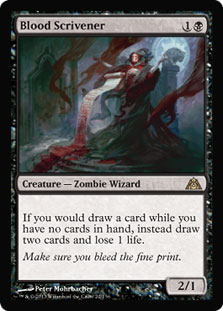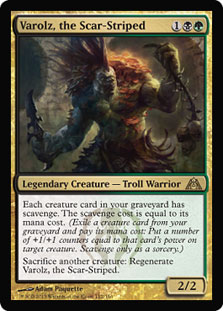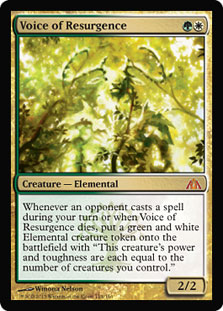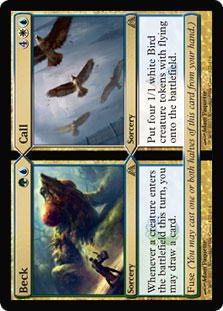Lately I’ve been suffering deeply from a personal issue. It’s been keeping me up at nights, distracting me from my work, and generally eating away at me. I thought that I could just tough it out and that time would eventually set things right, but things just keep getting worse. My problem is the Game of Thrones TV series on HBO.
Each installment finishes with a loose end, and all I can do is spend the week trying to predict how things are going to play out. But every time a new episode comes around, it only brings more characters, more stories, and more questions!
My friends, I’m not good with cliffhangers, and I’ve decided that having Game of Thrones in my life is already as much as I can handle! At least if things get too bad, I could bring myself to pick up the books. The Modern PTQ season, on the other hand, ended in a wholly unsatisfying way, and the answers to the questions still hanging over me aren’t available in writing!
The only thing to do is to write next season’s spoiler myself. How will the story flesh out between Birthing Pod and U/W/R? Will Eggs sit on the Iron Throne for long or be replaced? Is Affinity really dead or just searching for a deserving master?
Yes, the Modern PTQs came to an end with no clear best deck, little consensus on the ideal way to build a deck for any of the major archetypes, and not much agreement even on which decks had good matchups against which other decks! The season came to a finale at Grand Prix San Diego where eight distinct decks made up the Top 8. Over the next few weeks, I’ll be awaiting a possible banning or unbanning from Wizards of the Coast; I’ll be pouring my soul into a Modern Dragon’s Maze set review; and I’ll be preparing in every way that I can in an attempt to find some answers in time for Grand Prix Portland.
For now, I’ll start with what I do know:
Creatures (12)
Lands (23)
Spells (25)

I played a RUG midrange (I’d call it control by the standards of the Modern format) deck to modest success at my last Modern tournament, which was Grand Prix San Diego. This is a deck I’d worked on a lot in the old days before Bloodbraid Elf was banned. I liked a lot of things about the deck, but I could never quite get the Jund matchup where I wanted it, so I put it on the shelf for a while. After the banning dealt a blow to Jund in terms of both quality and popularity, I felt the time was right to give RUG a try in a major event.
This build of RUG is unique among control decks in terms of the mana efficiency of its threats. Instead of trying to reach seven mana for a Sphinx’s Revelation or a Scapeshift, RUG leans on cards like Vedalken Shackles and Huntmaster of the Fells, which are guaranteed to come down in a reasonable time frame. Between this quality and an extremely smooth, nearly monocolor mana base, RUG is one of the most consistent decks in the format. You can comfortably keep two-land hands, and Serum Visions and Thirst for Knowledge offer the ability to manage the number of lands you draw to the point that it sometimes feels as though you’re playing Legacy while the rest of your opponents are stuck in Modern.
The problem, of course, is that most of the threats and answers are the same between Legacy and Modern with card selection being the primary difference between the two. So when your opponent has a naturally good draw and you’re spending effort filtering your draws into good ones, you can be at a disadvantage. In short, like most Modern decks, RUG is going to feel great when you win the die roll and have the right answers at the right times, and it’s going to feel less than great when you get run over in the early turns…
The Decklist
My favorite thing about RUG is that it has access to unique and powerful noncreature threats that not many other decks in Modern can play. Vedalken Shackles, when unanswered, takes over a game like no other card can. In one of my matches against G/R Zoo, turn after turn I stole his creature, chump blocked with it, and repeated the process. If ever he decided to pass the turn without attacking, then fine! He was playing right into my game plan. In the best case, Vedalken Shackles wins the game on its own. In the worst case, it creates a board stall, which is the ideal situation for RUG between its board sweepers, Cryptic Commands, and card drawing. Relevantly, Shackles is also the ideal answer to a card like Etched Champion or really anything that can’t be killed with a Lightning Bolt.
The same Island-centric mana base that makes Vedalken Shackles excellent also supports Blood Moon. Blood Moon is the most underplayed card in Modern, and I think the reason is that people consider it to be a “Hail Mary” type of card where you have to catch your opponent off guard for it to be good. This is not the case at all.
A Blood Moon in play shuts off all manlands and colorless value lands, which often represent the advantages that other fair decks have over RUG in game 1. The mere threat of Blood Moon forces the opponent to fetch their lands and sequence their spells in an inconvenient way, offering some reprieve in those critical early turns. Even against a deck like U/W, which often plays a number of basic lands, Blood Moon will impede the opponent’s ability to cast Cryptic Command or to play multiple spells in the same turn. These are the reasons to play Blood Moon! That and I certainly won’t turn down those free wins every once in a while…
RUG makes the best use of Blood Moon because it has the tools to steer the game in a direction where Blood Moon will have the highest impact. You have burn for mana elves, permission for cards like Wall of Roots, and Cryptic Command to bounce a permanent that the opponent managed to sneak in under the Moon. You have card selection to help find Blood Moon when you need it and get rid of it when you don’t or when you have multiple copies.
In addition to Vedalken Shackles and Blood Moon, RUG uses Huntmaster of the Fells in a way that makes it seem like a different card from the Huntmaster played in Jund or any other nonblue deck. The goal of RUG is to pass the turn with all of its mana open. The goal of RUG is to Snapcaster Mage a spell on the opponent’s turn. It’s truly not uncommon to flip Huntmaster every single turn of the game until the opponent gives in. What’s more is that you need not fear instant speed removal if you’re passing with a counterspell in hand!
Comparison to Other RUG Decks
I built the RUG deck above after trying both RUG Delver and RUG Vial. While both archetypes inspired me in constructing my exact decklist, I feel that midrange RUG is simpler, smoother, and better than both.
Creatures (13)
Lands (21)
Spells (26)

The advantage that RUG vial has over midrange RUG is a stronger lategame against fair decks. However, I feel that to build your deck with this goal in mind is unnecessarily greedy since midrange RUG will already outclass every other fair deck as the game goes long (with the exception of some builds of U/W/x—more on this below). This lategame power is not particularly useful against fast aggro, combo, or a deck like Urzatron.
Playing Eternal Witness comes at three costs:
1. It ruins the mana base. Midrange RUG plays five maindeck green cards, all costing only single green. Eternal Command needs two green mana to function properly, which means adding awkward lands like Copperline Gorge and Flooded Grove. In addition to losing some number of extra games to inconvenient mana, this precludes you from playing Vedalken Shackles and Blood Moon, which, as I mentioned above, are primary reasons to play the RUG colors.
2. It makes you excessively reliant on the graveyard. You already play Snapcaster Mage and Tarmogoyf, meaning that something like a Rest in Peace will take away a lot of your tools in the course of a long game. Do you really need to construct your deck in such a way that it hurts more?
3. Eternal Witness is simply a slow, clunky card. RUG is strong in the lategame, and the early turns are where the game can be won or lost. Eternal Witness is a liability when it’s in your opening hand without an Aether Vial.
Aether Vial is a card that I have mixed feelings about. On one hand, it’s a powerful tool against combo decks and opposing permission decks because it allows you to play the game without tapping out on your main phase. On the other hand, it’s effectively a mana source that doesn’t cast many of your important spells (namely Cryptic Command) and is bad as a topdeck. It reduces the consistency of the deck, which, again, is a reason to be playing the RUG colors. Overall, I would hate to build around the card, but if one were to settle on a build a little bit heavier on creatures than my own, I could see playing one or two copies. The card is bad to draw in multiples, but having only a small number of copies makes it manageable to scry away or to discard to Thirst for Knowledge.
In terms of matchups, I see RUG Vial as having an advantage in the RU/G mirror and in game 1 against U/W/x decks. However, U/W/x decks tend to crumble against either Vedalken Shackles or Blood Moon, so I feel that the scales are balanced in that regard. (U/W/x can beat a Shackles or a Blood Moon, but both cards are extremely powerful tools when backed up by a good hand from the RUG player).
Creatures (15)
Lands (21)
Spells (24)

RUG Delver and midrange RUG are quite similar, with the main difference, of course, being the presence or absence of the actual card Delver of Secrets. I simply don’t feel that Delver contributes much to the deck. It’s a time sensitive card (you’re unlikely to be able to race in the air if the Delver doesn’t come down early), which is inconvenient for a deck that can see so many of its cards in the mid and late game.
There may have been a time when having Delver to clock combo decks was helpful, but that’s not very important today. There’s no racing Eggs—better to lock up the game with a permanent source of disruption like Relic of Progenitus or Glen Elendra Archmage or use flash creatures to win a carefully-paced game. Splinter Twin and Scapeshift can easily kill your Delvers anyway.
No, I prefer to focus my efforts on being a pure control deck. Vendilion Clique, Tarmogoyf, and Huntmaster of the Fells are good defensive cards and are also remarkably effective at turning the tables once you’re ready to do so.
Moving Forward
So in the wide world of Modern, RUG midrange is one character whose story I’ve followed all the way to a satisfying conclusion. I know just how good the deck is, I feel confident in my build, and I don’t think there will be any unsavory brothers or cousins who show up to supplant it. RUG is not the best deck, but it’s absolutely competitive and offers many advantages that can’t be found elsewhere in Modern.
That’s one question answered; only about 10,000 left to go. Next week, I’ll be working on a Dragon’s Maze set review, and my scouts are already reporting a lot that could potentially shake up the format…
One blast from the horn means friends returning.
Potential new tools for those who like Jund or other B/G midrange.
Two blasts from the horn means enemies to watch out for.
Cards that can be game changers in a matchup between one fair deck and another.
Three blasts from the horn…I’m not sure exactly what that means. Three blasts from the horn isn’t something that’s been heard in living memory.





